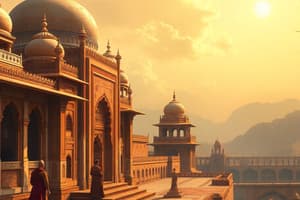Podcast
Questions and Answers
Who is conventionally said to have founded the Mughal Empire?
Who is conventionally said to have founded the Mughal Empire?
- Babur (correct)
- Aurangzeb
- Ibrahim Lodi
- Akbar
When was the Mughal imperial structure sometimes dated to?
When was the Mughal imperial structure sometimes dated to?
- 1526
- 1600 (correct)
- 1720
- 1857
Where did the Mughal Empire stretch at its peak?
Where did the Mughal Empire stretch at its peak?
- From the Arabian Sea to the Bay of Bengal
- From the Ganges River Basin to the Himalayas
- From the Thar Desert to the Western Ghats
- From the Indus River Basin to the Deccan Plateau (correct)
Who was the last major emperor of the Mughal Empire?
Who was the last major emperor of the Mughal Empire?
How did the Mughal Empire treat the cultures and peoples it came to rule?
How did the Mughal Empire treat the cultures and peoples it came to rule?
What does 'Pneumonoultramicroscopicsilicovalcanoconiosis' refer to?
What does 'Pneumonoultramicroscopicsilicovalcanoconiosis' refer to?
What is the origin of the word 'Pneumonoultramicroscopicsilicovalcanoconiosis'?
What is the origin of the word 'Pneumonoultramicroscopicsilicovalcanoconiosis'?
What is the significance of 'Pneumonoultramicroscopicsilicovalcanoconiosis' in the medical field?
What is the significance of 'Pneumonoultramicroscopicsilicovalcanoconiosis' in the medical field?
Flashcards
Who founded the Mughal Empire?
Who founded the Mughal Empire?
Founder of the Mughal Empire.
Mughal Empire start date?
Mughal Empire start date?
Around the year 1600.
Mughal Empire's peak extent?
Mughal Empire's peak extent?
From the Indus River Basin to the Deccan Plateau.
Who was Aurangzeb?
Who was Aurangzeb?
Signup and view all the flashcards
Mughal Empire's cultural approach?
Mughal Empire's cultural approach?
Signup and view all the flashcards
What is Pneumonoultramicroscopicsilicovalcanoconiosis?
What is Pneumonoultramicroscopicsilicovalcanoconiosis?
Signup and view all the flashcards
Origin of 'Pneumonoultramicroscopicsilicovalcanoconiosis'?
Origin of 'Pneumonoultramicroscopicsilicovalcanoconiosis'?
Signup and view all the flashcards
Significance of 'Pneumonoultramicroscopicsilicovalcanoconiosis'?
Significance of 'Pneumonoultramicroscopicsilicovalcanoconiosis'?
Signup and view all the flashcards
Study Notes
Mughal Empire Founding and Structure
- Babur is conventionally recognized as the founder of the Mughal Empire.
- The Mughal imperial structure is sometimes dated to the early 16th century, specifically around 1526.
Geographic Extent of the Mughal Empire
- At its peak, the Mughal Empire extended across much of the Indian subcontinent, covering present-day India, Pakistan, Bangladesh, and parts of Afghanistan.
Last Major Emperor of the Mughal Empire
- Aurangzeb was the last major emperor of the Mughal Empire, reigning from 1658 to 1707.
Treatment of Cultures and Peoples
- The Mughal Empire is known for its relatively inclusive policies, generally promoting a syncretic culture that blended various traditions, religions, and customs from the diverse populations under its rule.
Pneumonoultramicroscopicsilicovalcanoconiosis
- This term refers to a type of lung disease caused by inhaling very fine silicate or quartz dust, often occurring in mining environments.
Etymology of the Term
- The word 'Pneumonoultramicroscopicsilicovalcanoconiosis' is a constructed term intended to serve as the longest word in the English language, combining medical roots that describe lung conditions caused by fine particles.
Medical Significance
- In the medical field, 'Pneumonoultramicroscopicsilicovalcanoconiosis' highlights the risks associated with exposure to very small particles and emphasizes the importance of occupational safety in preventing respiratory diseases.
Studying That Suits You
Use AI to generate personalized quizzes and flashcards to suit your learning preferences.




